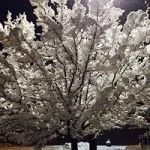Ice storms: Study looks at how they affect forests
Posted: January 26, 2017Source: Poughkeepsie Journal

IMAGE BY STACEY WESCHE / FOREST BUSINESSNETWORK
Early this year, researchers will head to a giant outdoor laboratory in New Hampshire armed with warm clothing, helmets and high-pressure firefighting pumps.
The scientists will re-create ice storms by spraying portions of the Hubbard Brook Experimental Forest with water.
It will mark the second year of a National Science Foundation-funded effort to understand what happens to a forest’s complex ecology when ice storms hit with regularity.
“It is the first-ever experimental ice storm in the world,” said Lindsey Rustad, a research ecologist with the U.S. Forest Service. Rustad will give a talk on the project in February at the Cary Institute of Ecosystem Studies in Millbrook.
The work is underscored by climate models that show ice storms are likely to become more frequent in the Northeast in the coming decades.
Peter Groffman, a Cary biologist on the research team, said natural environments can bounce back from disturbances.
But if they keep happening too frequently, “eventually, they don’t bounce back,” Groffman said.
Hubbard Brook is one of 80 experimental forests and ranges that have been established by the U.S. Forest Service since 1908. The 7,700-acre preserve in central New Hampshire was set aside in 1955 for studies just like this one.
Scientists have limited understanding of the ecological effects of ice storms for a simple reason — the storms are hard to predict.
But they can be devastating. In January 1998, a massive, five-day storm downed trees and infrastructure across portions of Canada and the Northeast, including some areas in upstate New York. (Locally, the precipitation fortunately came as rain, causing some minor flooding.)
It is the only ice storm ever to make the National Oceanic and Atmospheric Association’s list of billion-dollar weather and climate disasters.
Hubbard Brook was among the areas where trees suffered significant damage.
To re-create the storm, the scientists will wait until the conditions are just right. Then, using the firefighting pumps, they create a number of different ice conditions in plots about the size of a basketball court.
They simulate storms producing a quarter of an inch, half an inch and three quarters of an inch of ice. The difference between a quarter of a inch and three quarters is the difference between a significant ice storm and an epic one.
Then comes the data collection and analysis.
“One of the things we are really trying to test is, if you have repeated ice storms, will they have a much more dramatic effect on the forest?” Groffman said.
Already, the scientists have begun quantifying the precise amount of woody debris that falls in each of the scenarios. Those hard data are useful to firefighters, first-responders and foresters.
“The folks that we talk to are hungry for numbers,” said Rustad of the forest service, “so that they can begin to plan their salvage cuts, their recovery efforts and how to respond to these ice storms.”
This year’s experiments will allow scientists to measure the response after back-to-back storms.
“The forest has a certain amount of what we think of as stored sugars and carbohydrates,” Rustad said. “It’s this stored material that the forest uses to repair itself. … But if you hit it twice, it doesn’t have the same amount of reserves to come back.”
